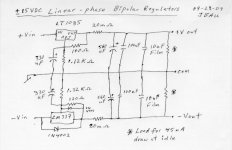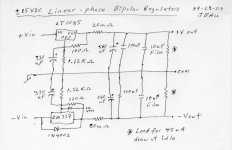
And from wacky TNTaudio:
317
Simple Voltage Regulators Part 2: Output Impedance
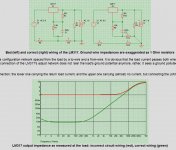
vs 431:
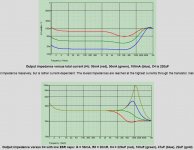
Simple Voltage Regulators Chapter 2: Output Impedance
Last edited:
I've built regulator using TPS7A4700, connected two of them to get symmetrical output voltage. Comparing to LT108x regulators or LM317, this one is much more cleaner and detailed in sound.
BR,
Ales
I didn't know voltage regulators put out sound? As far as noise goes, learn about power supply rejection and how it keeps the supply noise out of the output. The noise at the output of an amp is almost entirely from the amp, and usually from the input stage. (Look at the noise (ripple) on the rails of a power amp that has 110db s/n at the output.)
Last edited:
DIYHiFi.org • View topic - To clock or not to clock, that is the question...
or is it a 'flea' type reg?
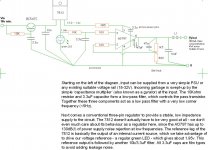
or is it a 'flea' type reg?

A lm350 feeding an array of shunts tl431 from ON semiconductors bypassed with low esr caps then feeding an emitter follower... with a little smt inductor at the output, et hop ?!
Before the LM350 a double Pi with common inductor (also one before the traffo) then two standalone serie inductor (+V & 0V)with a last big caps with a low esr !
Is Abraxalito one near this scheme 🙂 but with a babel tower caps 😉
Before the LM350 a double Pi with common inductor (also one before the traffo) then two standalone serie inductor (+V & 0V)with a last big caps with a low esr !
Is Abraxalito one near this scheme 🙂 but with a babel tower caps 😉
If you're aiming for low noise alone, your wasting your time trying to achieve better performance than the ADM7150. Ever the doubting Thomas, I ran the noise test with the SYS2722 and can confirm the data shown on the first page of the data sheet.
My application is to feed 7 dual opamps at +/-15V in an EQ. I understand PSRR is going to be key in the overall preamp being quiet. Like yajnaS pointed out in the first page, the L7815/L7915 are ancient designs and I figured there were better alternatives these days for regulators, especially with noise figures, stability and maybe even output impedance. I am having a real hard time finding any more modern through hole designs though. Quite frankly, I am blown away to find out that the LM317 is still relevant. Unless there is some kind of surface mount to through hole adapter with a way to heat sink to the chip that I am missing, I am not really finding any other options for my preamp.
AudioLD, I'm also surprised to read in the link you posted in #20 that there were descriptions of the differences in sound when changing the regulators or even the values of the caps/resistors on the 317. Is this because it was powering a D/A and they are sensitive to different output impedances or because the output was oscillating or something like that? Did you get to do the impedance sweeps with the 78/79's yet?
AudioLD, I'm also surprised to read in the link you posted in #20 that there were descriptions of the differences in sound when changing the regulators or even the values of the caps/resistors on the 317. Is this because it was powering a D/A and they are sensitive to different output impedances or because the output was oscillating or something like that? Did you get to do the impedance sweeps with the 78/79's yet?
...
AudioLD, I'm also surprised to read in the link you posted in #20 that there were descriptions of the differences in sound when changing the regulators or even the values of the caps/resistors on the 317. Is this because it was powering a D/A and they are sensitive to different output impedances or because the output was oscillating or something like that? Did you get to do the impedance sweeps with the 78/79's yet?
I have no idea, i'm just a collector of info.
here's his final suggestion:
diyAudio
"Sweeps" ?!?, I wish! All I have is a DMM!
Attachments
Last edited:
😎😎Heck yeah I found the modern through hole design for you!
I think I am gonna try this because my Sanyo LC75342 preamp is very loud but ugly as heck about the noise and I don't know how to use my scope to find the source of the noise yet. TPS7A4700-LM31X Ultra Low Noise LDO Voltage Regulator
I think I am gonna try this because my Sanyo LC75342 preamp is very loud but ugly as heck about the noise and I don't know how to use my scope to find the source of the noise yet. TPS7A4700-LM31X Ultra Low Noise LDO Voltage Regulator
My application is to feed 7 dual opamps at +/-15V in an EQ. I understand PSRR is going to be key in the overall preamp being quiet. Like yajnaS pointed out in the first page, the L7815/L7915 are ancient designs and I figured there were better alternatives these days for regulators, especially with noise figures, stability and maybe even output impedance. I am having a real hard time finding any more modern through hole designs though. Quite frankly, I am blown away to find out that the LM317 is still relevant. Unless there is some kind of surface mount to through hole adapter with a way to heat sink to the chip that I am missing, I am not really finding any other options for my preamp.
AudioLD, I'm also surprised to read in the link you posted in #20 that there were descriptions of the differences in sound when changing the regulators or even the values of the caps/resistors on the 317. Is this because it was powering a D/A and they are sensitive to different output impedances or because the output was oscillating or something like that? Did you get to do the impedance sweeps with the 78/79's yet?
My application is to feed 7 dual opamps at +/-15V in an EQ. I understand PSRR is going to be key in the overall preamp being quiet. Like yajnaS pointed out in the first page, the L7815/L7915 are ancient designs and I figured there were better alternatives these days for regulators, especially with noise figures, stability and maybe even output impedance. I am having a real hard time finding any more modern through hole designs though. Quite frankly, I am blown away to find out that the LM317 is still relevant. Unless there is some kind of surface mount to through hole adapter with a way to heat sink to the chip that I am missing, I am not really finding any other options for my preamp.
AudioLD, I'm also surprised to read in the link you posted in #20 that there were descriptions of the differences in sound when changing the regulators or even the values of the caps/resistors on the 317. Is this because it was powering a D/A and they are sensitive to different output impedances or because the output was oscillating or something like that? Did you get to do the impedance sweeps with the 78/79's yet?
You could do worse than with the SilentSwitcher in the diyaudio store. Extremely low noise, and able to be fed from a mains-free Powerbank.
Not through-hole, but worry-free and ready to roar!
Jan
DIYHiFi.org • View topic - To clock or not to clock, that is the question...
or is it a 'flea' type reg?
View attachment 448945
The basic mistake here is that the reference decoupling is referred to a dirty ground rather than the load return point, like the 820R resistor.
Jan
There are more modern LDO for clean power. Some examples below:
- Dual in one IC : TI TPS7A39 (perfect for +/15V for audio AOP) but package is QFN, not SO.
- LT3062, and the series LT308X, LT309X .... some TPSXXXX at TI, ....
Go to the IC manufacturers website and type LDO with ultra low noise or LDO and take a look at the noise parameter (the goal of these IC is primary to power RF circuits or DAC but it is very interesting for Audio circuits too). You can achive a few µV of noise only at the output.
- Dual in one IC : TI TPS7A39 (perfect for +/15V for audio AOP) but package is QFN, not SO.
- LT3062, and the series LT308X, LT309X .... some TPSXXXX at TI, ....
Go to the IC manufacturers website and type LDO with ultra low noise or LDO and take a look at the noise parameter (the goal of these IC is primary to power RF circuits or DAC but it is very interesting for Audio circuits too). You can achive a few µV of noise only at the output.
Watch out for "low noise" in the context of RF components - it usually confined to 1MHz and up - there can be dreadful 1/f noise without it mattering at all for many RF applications.
However regulators for VFO's are an exception - oscillators mix DC up to the output signal as phase noise, so good low frequency noise performance is a big selling point in this applcation, both for oscillator devices and regulators that power them.
However regulators for VFO's are an exception - oscillators mix DC up to the output signal as phase noise, so good low frequency noise performance is a big selling point in this applcation, both for oscillator devices and regulators that power them.
- Home
- Amplifiers
- Power Supplies
- What Linear Regulator Chips Have the Lowest Noise Figures?

